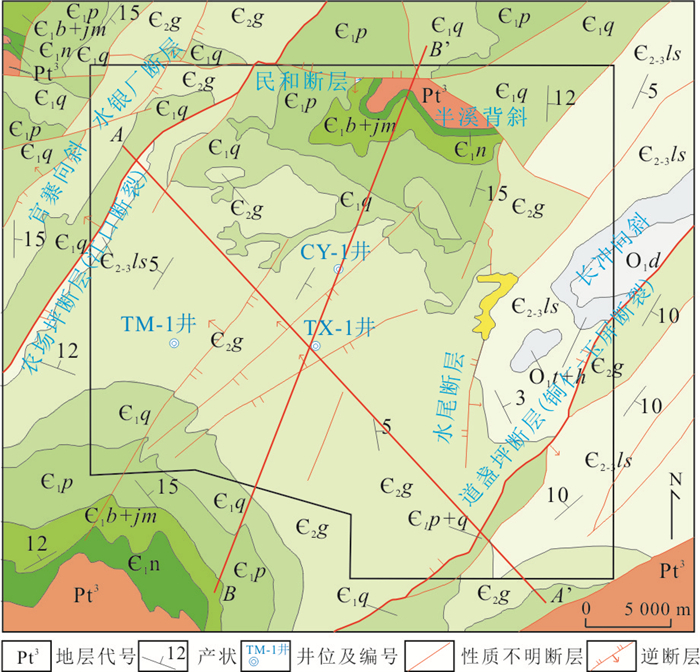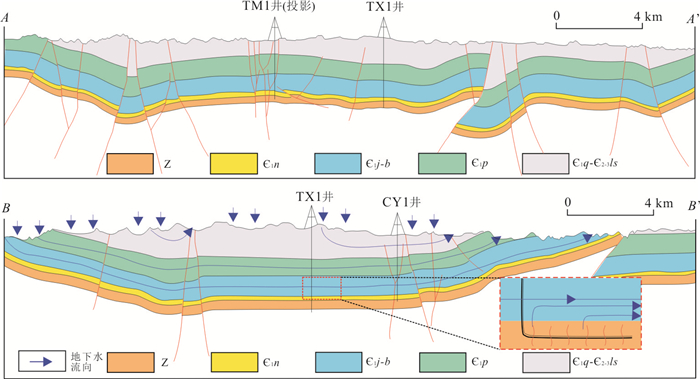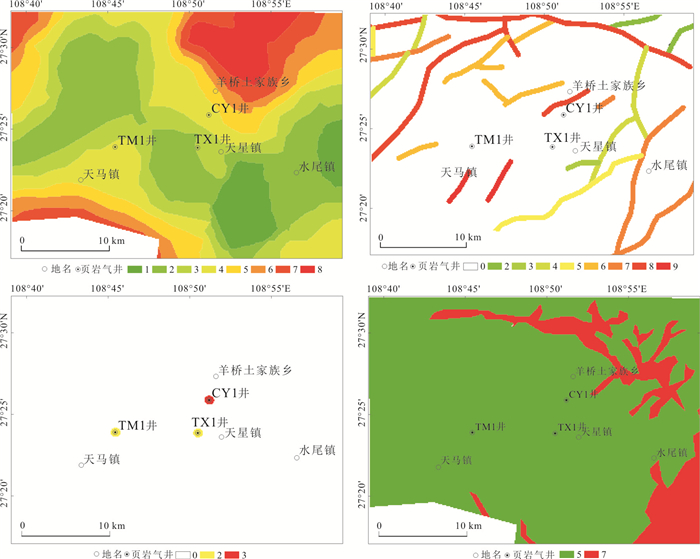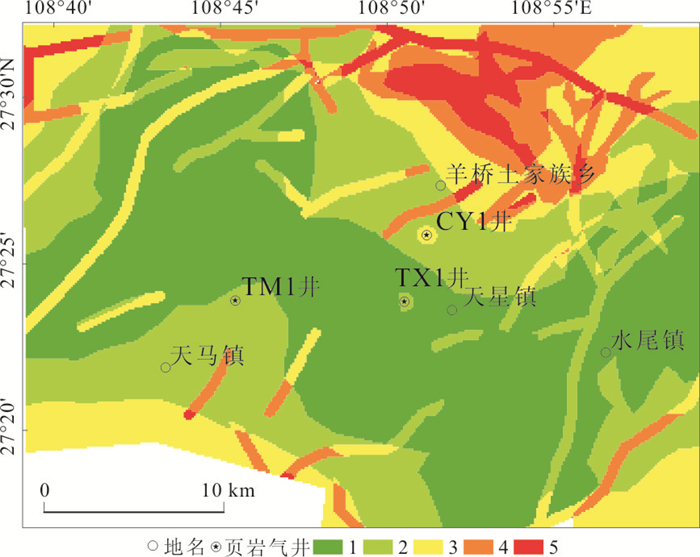Deep Vulnerability Assessment of Hydraulic Fracturing Effect on Groundwater
-
摘要: 为评价区块尺度页岩气开采过程中深部污染物对上部含水层的污染风险,基于“源-途径-驱动力-受体”概念模型,采用层次分析法构建了页岩气开采对地下水影响的深部脆弱性评价指标体系.利用该体系对贵州省某页岩气开采区块进行了评价,结果表明:评价区地下水深部脆弱性以低和较低为主,两者面积占研究区总面积的69.15%,主要分布于研究区西北部、中部及东南部,中间层厚度是影响评价结果的主要指标.该评价体系能够评估页岩气开采区地下水深部脆弱性,丰富了现有地下水脆弱性评价体系,可为区块内页岩气井的布设选址及地下水环境保护提供技术支撑.Abstract: In order to evaluate the pollution risk of deep pollution sources on upper aquifer during shale gas exploitation, the deep vulnerability assessment index system of groundwater was built up by analytic hierarchy process from three aspects:natural protection, impact route and driving force, based on the "source-pathway-drive-receptor" conceptual model. In addition, groundwater deep vulnerability assessment of shale gas mining block in Guizhou Province was assessed as an example. The results show the deep groundwater vulnerability rank mainly is low and medium-low in the study area, accounting for 69.15% of the total area, which is distributed in the northwest, central and southeast of the study area. The thickness of the intermediate layer is the main indicator affecting the evaluation. The evaluation system can be applied to the groundwater deep vulnerability assessment of shale gas exploitation area, enriching the existing groundwater vulnerability assessment system, and providing technical support for shale gas well layout and groundwater environmental protection.
-
Key words:
- shale gas /
- groundwater /
- deep vulnerability assessment /
- conceptual model /
- hydrogeology
-
图 3 研究区地质构造样式及地下水流系统示意图
据王濡岳等(2016)修改
Fig. 3. Geological structural styles and groundwater flow system schematic map of the study area
表 1 深部脆弱性评价指标评分体系
Table 1. Rating system of deep vulnerability index
天然防护 影响途径 驱动力 中间层厚度(m) 中间层等效渗透系数(m/s) 断层底部距储层的距离(m) 断层性质 井龄(a) 地层压力系数 地形高差(m) 范围 评分 范围 评分 范围 评分 断层类型 断层泥比例 评分 范围 评分 范围 评分 范围 评分 < 100 9 > 10 -5 9 < 100 10 四级断层 50% 2 < 5 1 < 0.75 1 < 500 1 100~300 8 10 -5~10 -6 8 100~200 9 30% 3 5~10 2 0.75~0.9 3 500~1 000 3 300~500 7 10 -6~10 -7 7 200~300 8 三级断层 50% 4 10~15 3 0.9~1.2 5 1 000~1 500 5 500~700 6 10 -7~10 -8 6 300~400 7 30% 5 15~20 5 1.2~1.5 7 1 500~2 000 7 700~900 5 10 -8~10 -9 5 400~500 6 二级断层 50% 6 20~25 7 > 1.5 9 > 2 000 9 900~1 100 4 10 -9~10 -10 4 500~600 5 30% 7 > 25 9 1 100~1 300 3 10 -10~10 -11 3 600~700 4 一级断层 50% 8 1 300~1 500 2 10 -11~10 -12 2 700~800 3 30% 9 > 1 500 1 < 10 -12 1 800~900 2 > 900 1 表 2 准则层权重矩阵
Table 2. Weight matrix of Criteria layer
评价指标 天然防护 影响途径 驱动力 天然防护 1 8/7 8/7 影响途径 7/8 1 1 驱动力 7/8 1 1 表 3 影响途径指标权重矩阵
Table 3. Weight matrix of index of potential impact pathway
评价指标 断层底部距储层距离 断层性质 井龄 断层底部距储层距离 1 8/6 8/8 断层性质 6/8 1 6/8 井龄 8/8 8/6 1 表 4 深部脆弱性评价指标权重
Table 4. Weight of deep vulnerability index
准则层 权重 指标层 权重 天然防护 0.36 中间层厚度(m) 0.55 中间层渗透系数 0.45 影响途径 0.32 断层底部距储层的距离(m) 0.36 断层性质 0.28 井龄(a) 0.36 驱动力 0.32 地层压力系数 0.40 地形高差(m) 0.60 表 5 中间层渗透率及数据来源
Table 5. Permeability of intermediate layers and data source
序号 地层 渗透率(μm2) 数据来源 1 清虚洞组 均值1.5×10-5 贺永忠等(2015) 2 杷榔组、变马冲组 1×10-9 ~ 9×10-7 赵泽恒等(2007) 3 九门冲组 1.99×10-7 ~ 4.25×10-5 王濡岳等(2016
赵泽恒等(2007) -
Birdsell, D. T., Rajaram, H., Dempsey, D., et al., 2015. Hydraulic Fracturing Fluid Migration in the Subsurface: A Review and Expanded Modeling Results. Water Resources Research, 51(9): 7159-7188. https://doi.org/10.1002/2015wr017810 doi: 10.1002/2015WR017810 Brufatto, C., Cochran, J., Conn, L., et al., 2003.From Mud to Cement—Building Gas Wells. Oil Field Review, 15(3):62-76. Cai, Z. S., Ofterdinger, U., 2014. Numerical Assessment of Potential Impacts of Hydraulically Fractured Bowland Shale on Overlying Aquifers. Water Resources Research, 50(7): 6236-6259. https://doi.org/10.1002/2013wr014943 doi: 10.1002/2013WR014943 Chen, J.Y., Yang, X.S., Dang, J.X., et al., 2011.Internal Structure and Permeability of Wenchuan Earthquake Fault. Chinese Journal of Geophysics, 54(7):1805-1816 (in Chinese with English abstract). http://www.wanfangdata.com.cn/details/detail.do?_type=perio&id=dqwlxb201107014 Engle, M. A., Reyes, F. R., Varonka, M. S., et al., 2016. Geochemistry of Formation Waters from the Wolfcamp and "Cline" Shales: Insights into Brine Origin, Reservoir Connectivity, and Fluid Flow in the Permian Basin, USA.Chemical Geology, 425: 76-92. https://doi.org/10.1016/j.chemgeo.2016.01.025 Fan, Q., Wang, G.L., Lin, W.J., et al., 2007. New Method for Evaluating the Vulnerability of Groundwater. Journal of Hydraulic Engineering, 38(5):601-605 (in Chinese with English abstract). http://www.wanfangdata.com.cn/details/detail.do?_type=perio&id=slxb200705014 Gu, H.L., Yue, X.J., Chen, H.H., et al., 2018. Assessment Model of Groundwater Vulnerability in Shale Gas Exploitation Area.WaterResourceProtection, 34(5):57-62 (in Chinese with English abstract). http://d.old.wanfangdata.com.cn/Periodical/szybh201805009 Guan, X., Zuo, R., Meng, L., et al., 2017.Study on Evaluation Method of Site Suitability for River Water Sources. China Sciencepaper, 12(3):319-326 (in Chinese with English abstract). http://www.wanfangdata.com.cn/details/detail.do?_type=perio&id=zgkjlwzx201703013 Harrison, S. S., 1983. Evaluating System for Ground-Water Contamination Hazards Due to Gas-Well Drilling on the Glaciated Appalachian Plateau. Ground Water, 21(6): 689-700. https://doi.org/10.1111/j.1745-6584.1983.tb01940.x He, Y.Z., Chen, H.G., Xie, Y., et al., 2015.Discovery of Cambrian Carbonate Platform Margin Shoal in the Southeastern Margin of Upper Yangtze Platform and Its Geological Significance—Example from Shiqian-Cengong Area of Guizhou Province. Geological Survey of China, 2(5):38-44 (in Chinese with English abstract). http://en.cnki.com.cn/Article_en/CJFDTotal-DZDC201505006.htm Jackson, R. E., Gorody, A. W., Mayer, B., et al., 2013. Groundwater Protection and Unconventional Gas Extraction: The Critical Need for Field-Based Hydrogeological Research. Groundwater, 51(4): 488-510. https://doi.org/10.1111/gwat.12074 Jiang, G.H., 2002. Study on Groundwater Vulnerability in Guan Zhong Basin (Dissertation).Chang'an University, Xi'an (in Chinese with English abstract). Jin, A.F., Li, G.H., Zhang, X., et al., 2012.The Risk Source Identification and Classification Methodology of Groundwater Pollution. Earth Science, 37(2):247-252 (in Chinese with English abstract). http://cn.bing.com/academic/profile?id=cfeaf96d11f5c80e008d7b068032f2df&encoded=0&v=paper_preview&mkt=zh-cn Kissinger, A., Helmig, R., Ebigbo, A., et al., 2013. Hydraulic Fracturing in Unconventional Gas Reservoirs: Risks in the Geological System, Part 2. Environmental Earth Sciences, 70(8): 3855-3873. https://doi.org/10.1007/s12665-013-2578-6 Ladevèze, P., Séjourné, S., Rivard, C., et al., 2017. Defining the Natural Fracture Network in a Shale Gas Play and Its Cover Succession: The Case of the Utica Shale in Eastern Canada. Journal of Structural Geology, 108: 157-170. https://doi.org/10.1016/j.jsg.2017.12.007 http://cn.bing.com/academic/profile?id=d8ad1e5832aa26c60c84e9cc08997dae&encoded=0&v=paper_preview&mkt=zh-cn Lange, T., Sauter, M., Heitfeld, M., et al., 2013. Hydraulic Fracturing in Unconventional Gas Reservoirs: Risks in the Geological System Part 1. Environmental Earth Sciences, 70(8): 3839-3853. https://doi.org/10.1007/s12665-013-2803-3 Li, S.K., Yuan, Y., Li, X., et al., 2018.Building up a Risk Assessment Index System of Groundwater Pollution in Shale Gas Development. Research of Environmental Sciences, 31(5):911-918 (in Chinese with English abstract). http://www.wanfangdata.com.cn/details/detail.do?_type=perio&id=hjkxyj201805015 Liang, C., Jiang, Z. X., Cao, Y. C., et al., 2017. Sedimentary Characteristics and Paleoenvironment of Shale in the Wufeng-Longmaxi Formation, North Guizhou Province, and Its Shale Gas Potential.Journal of Earth Science, 28(6): 1020-1031. https://doi.org/10.1007/s12583-016-0932-x Lin, M., Ji, D.F., Cui, C.F., et al., 2016.Groundwater Vulnerability Partition in Ashi River Basin. Research of Environmental Sciences, 29(12):1773-1781 (in Chinese with English abstract). http://d.old.wanfangdata.com.cn/Periodical/hjkxyj201612006 Ma, J.Z., 2001.Groundwater Vulnerability Assessement for the South Rim of Tarim Basin. Journal of Desert Research, 21(2) :170-174 (in Chinese with English abstract). http://www.wanfangdata.com.cn/details/detail.do?_type=perio&id=zgsm200102012 Pfunt, H., Houben, G., Himmelsbach, T., 2016. Numerical Modeling of Fracking Fluid Migration through Fault Zones and Fractures in the North German Basin. Hydrogeology Journal, 24(6): 1343-1358. https://doi.org/10.1007/s10040-016-1418-7 Reagan, M. T., Moridis, G. J., Keen, N. D., et al., 2015. Numerical Simulation of the Environmental Impact of Hydraulic Fracturing of Tight/Shale Gas Reservoirs on Near-Surface Groundwater: Background, Base Cases, Shallow Reservoirs, Short-Term Gas, and Water Transport. Water Resources Research, 51(4): 2543-2573. https://doi.org/10.1002/2014wr016086 doi: 10.1002/2014WR016086 Vengosh, A., Jackson, R. B., Warner, N., et al., 2014. A Critical Review of the Risks to Water Resources from Unconventional Shale Gas Development and Hydraulic Fracturing in the United States. Environmental Science & Technology, 48(15): 8334-8348. https://doi.org/10.1021/es405118y http://www.wanfangdata.com.cn/details/detail.do?_type=perio&id=2ac0752f312291dd5e2a2744fa928ab4 Wang, M.M., Chen, Y.J., Xing, Z.G., et al., 2018.Groundwater Vulnerability Assessment of Open-Pit Coal Mine in Steppe Area Based on DRTIC-SL. China Mining Magazine, 27(10):165-169 (in Chinese with English abstract). http://www.wanfangdata.com.cn/details/detail.do?_type=perio&id=zgky201810035 Wang, R.Y., Ding, W.L., Gong, D.J., et al., 2016.Gas Preservation Conditions of Marine Shale in Northern Guizhou Area:A Case Study of the Lower Cambrian Niutitang Formation in the Cen'gong Block, Guizhou Province. Oil & Gas Geology, 37(1):45-55 (in Chinese with English abstract). http://www.en.cnki.com.cn/Article_en/CJFDTOTAL-SYYT201601008.htm Wang, S.L., 2017.The Influence of Structure on Accumulation of Shale Gas in Lower Cambrian Niutitang Formation in Cen'gong, Guizhou (Dissertation).Guizhou University, Guiyang (in Chinese with English abstract). Wang, X.C., Wu, G., Yan, J.D., 2018.Current Status and Trends of Shale Gas Development and Technology Development in the World. China Scitechnology Business, (12):17-21 (in Chinese with English abstract). http://www.wanfangdata.com.cn/details/detail.do?_type=perio&id=e0d584d0426f0a997dd8eb350f193872 Wang, Y.F., Zhai, G.Y., Leng, J.G., et al., 2017.Well TX1 Fracturing Effect Evaluation of Niutitang Formation Shale in Cengong, Guizhou. Earth Science, 42(7):1107-1115 (in Chinese with English abstract). http://www.wanfangdata.com.cn/details/detail.do?_type=perio&id=dqkx201707007 Wang, Z.H., Deng, M., Cheng, J.X., et al., 2018.Influence of Fault and Magmatism on Oil and Gas Preservation Condition, to the West of Kangdian Ancient Continent: Taking Yanyuan Basin as an Example. Earth Science, 43(10):3616-3624 (in Chinese with English abstract). http://en.cnki.com.cn/Article_en/CJFDTotal-DQKX201810022.htm Warner, N. R., Jackson, R. B., Darrah, T. H., et al., 2012. Reply to Engelder: Potential for Fluid Migration from the Marcellus Formation Remains Possible. Proceedings of the National Academy of Sciences, 109(52): E3626. https://doi.org/10.1073/pnas.1217974110 Wilson, M. P., Worrall, F., Davies, R. J., et al., 2017. Shallow Aquifer Vulnerability from Subsurface Fluid Injection at a Proposed Shale Gas Hydraulic Fracturing Site. Water Resources Research, 53(11): 9922-9940. https://doi.org/10.1002/2017wr021234 doi: 10.1002/2017WR021234 Xie, C.B., Yuan, H.Y., Guo, Y.Y., 1996.Multi-Factor's Weight Allocation Model. Journal of North China Institute of Water Conservancy and Hydroelectric Power, 17(4):31-37 (in Chinese with English abstract). http://en.cnki.com.cn/Article_en/CJFDTotal-HBSL604.005.htm Zhang, D.X., Yang, T.Y., 2015.Environmental Impacts of Hydraulic Fracturing in Shale Gas Development in the United States. Petroleum Exploration and Development, 42(6):801-807 (in Chinese with English abstract). Zhao, Z.H., Xue, X.L., Zhang, G.Q., et al., 2007. Hydrocarbon Potential of Lower Paleozoic Formations in Huangping Sag. Marine Origin Petroleum Geology, 12(3):33-43 (in Chinese with English abstract). http://www.wanfangdata.com.cn/details/detail.do?_type=perio&id=hxyqdz200703007 陈建业, 杨晓松, 党嘉祥, 等, 2011.汶川地震断层带结构及渗透率.地球物理学报, 54(7):1805-1816. doi: 10.3969/j.issn.0001-5733.2011.07.014 范琦, 王贵玲, 蔺文静, 等, 2007.地下水脆弱性评价方法的探讨及实例.水利学报, 38(5):601-605. doi: 10.3321/j.issn:0559-9350.2007.05.014 辜海林, 岳晓晶, 陈鸿汉, 等, 2018.页岩气开采区地下水脆弱性评价模型.水资源保护, 34(5):57-62. http://d.old.wanfangdata.com.cn/Periodical/szybh201805009 关鑫, 左锐, 孟利, 等, 2017.傍河水源地选址适宜性评价方法研究.中国科技论文, 12(3):319-326. doi: 10.3969/j.issn.2095-2783.2017.03.013 贺永忠, 陈厚国, 谢渊, 等, 2015.上扬子东南缘寒武系碳酸盐岩台缘滩的发现与油气地质意义——以贵州石阡-岑巩为例.中国地质调查, 2(5):38-44. http://www.cnki.com.cn/Article/CJFDTotal-DZDC201505006.htm 姜桂华, 2002.关中盆地地下水脆弱性研究(硕士学位论文).西安: 长安大学. 金爱芳, 李广贺, 张旭, 等, 2012.地下水污染风险源识别与分级方法.地球科学, 37(2):247-252. http://www.cnki.com.cn/Article/CJFDTotal-DQKX201202008.htm 李绍康, 袁颖, 李翔, 等, 2018.页岩气开发地下水污染风险评价指标体系构建.环境科学研究, 31(5):911-918. http://d.old.wanfangdata.com.cn/Periodical/hjkxyj201805015 林茂, 纪丹凤, 崔驰飞, 等, 2016.阿什河流域地下水脆弱性分区.环境科学研究, 29(12):1773-1781. http://d.old.wanfangdata.com.cn/Periodical/hjkxyj201612006 马金珠, 2001.塔里木盆地南缘地下水脆弱性评价.中国沙漠, 21(2) :170-174. doi: 10.3321/j.issn:1000-694X.2001.02.012 王淼淼, 陈宜金, 邢朕国, 等, 2018.基于DRTIC-SL的草原区露天煤矿地下水脆弱性评价.中国矿业, 27(10):165-169. http://d.old.wanfangdata.com.cn/Periodical/zgky201810035 王濡岳, 丁文龙, 龚大建, 等, 2016.黔北地区海相页岩气保存条件——以贵州岑巩区块下寒武统牛蹄塘组为例.石油与天然气地质, 37(1):45-55. http://www.wanfangdata.com.cn/details/detail.do?_type=perio&id=syytrqdz201601007 王生林, 2017.黔东南岑巩地区构造对牛蹄塘组页岩气成藏的影响(硕士学位论文).贵阳: 贵州大学. 王晓川, 吴根, 闫金定, 2018.世界页岩气开发及技术发展现状与趋势.科技中国, (12):17-21 doi: 10.3969/j.issn.1673-5129.2018.12.005 王玉芳, 翟刚毅, 冷济高, 等, 2017.贵州岑巩TX1井牛蹄塘组页岩压裂效果评价.地球科学, 42(7):1107-1115. http://www.cnki.com.cn/Article/CJFDTotal-DQKX201707006.htm 王正和, 邓敏, 程锦翔, 等, 2018.康滇古陆西侧断裂及岩浆活动对油气保存条件的影响:以盐源盆地为例.地球科学, 43(10):3616-3624. http://www.cnki.com.cn/Article/CJFDTotal-DQKX201810022.htm 谢崇宝, 袁宏源, 郭元裕, 1996.多指标权重分配模型研究.华北水利水电学院学报, 17(4):31-37. http://www.cnki.com.cn/Article/CJFDTotal-HBSL604.005.htm 张东晓, 杨婷云, 2015.美国页岩气水力压裂开发对环境的影响.石油勘探与开发, 42(6):801-807. http://d.old.wanfangdata.com.cn/Periodical/syktykf201506014 赵泽恒, 薛秀丽, 张桂权, 等, 2007.贵州黄平凹陷下古生界油气勘探潜力.海相油气地质, 12(3):33-43. doi: 10.3969/j.issn.1672-9854.2007.03.007 -









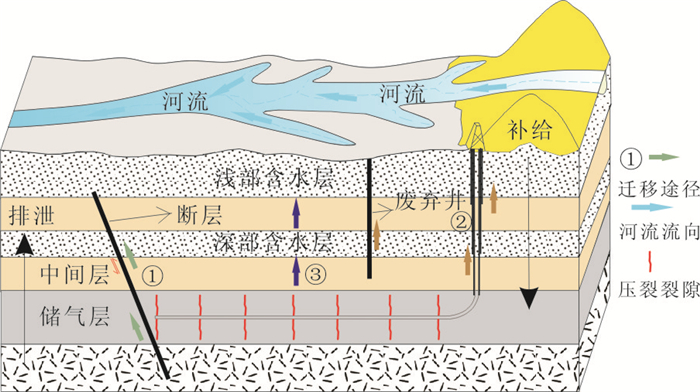
 下载:
下载:
